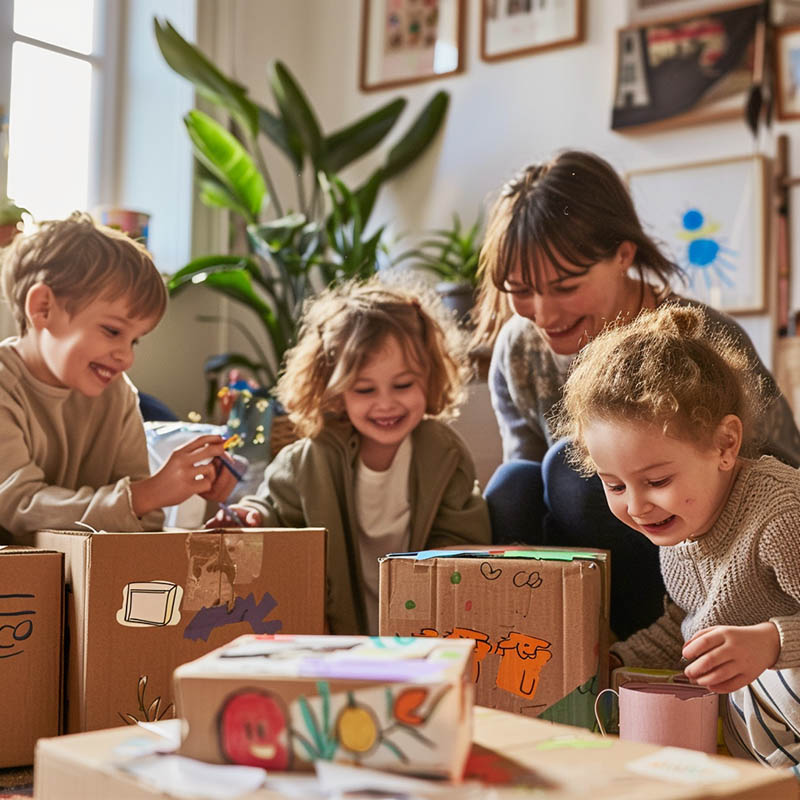Planning and Preparation
Create a Moving Checklist
A moving checklist is essential for organising tasks and ensuring nothing is overlooked. This comprehensive guide helps manage time efficiently and reduces stress during the moving process.
1. Two Months Before Moving
Research Moving Options:
- Decide between hiring professional movers or a DIY move.
- Obtain quotes from moving companies and compare prices.
- Read reviews and check references for potential movers.
- Schedule an in-home estimate if needed.
- Confirm insurance coverage for your belongings during the move.
Notify Important Parties:
- Inform your landlord, if renting, about your move-out date.
- Notify your children’s school about the relocation and obtain necessary transfer documents.
- Contact your employer to arrange time off for moving day if required.
Begin Decluttering:
- Start sorting through your belongings to decide what to keep, donate, or discard.
- Host a garage sale or schedule donations for unwanted items.
- Separate items to be recycled or thrown away.
- Consider digitalising documents to reduce paper clutter.
Gather Packing Supplies:
- Purchase or collect moving boxes, packing tape, bubble wrap, and markers.
- Consider reusable packing materials to minimise waste.
- Stock up on specialty boxes for fragile items, such as dish packs and wardrobe boxes.
Create a Budget:
- Estimate moving expenses, including packing supplies, transportation, and temporary accommodation if needed.
- Set aside funds for unexpected costs.
- Track all moving-related expenses to stay within budget.
- Compare costs of various moving options to find the best deal.
2. One Month Before Moving
Start Packing Non-Essentials:
- Begin packing items you won’t need in the next month, such as seasonal clothing and decorations.
- Clearly label each box with its contents and destination room.
- Use colour-coded labels for different rooms to simplify unpacking.
Organise Important Documents:
- Gather important documents like birth certificates, medical records, and school records in a secure folder.
- Keep this folder accessible throughout the move.
- Make copies of essential documents and store them separately.
Confirm Moving Arrangements:
- Finalise the date and time with your moving company or rental truck service.
- Arrange for any additional services, such as packing assistance or storage.
- Confirm details and provide clear instructions to movers.
Notify Service Providers:
- Contact utility companies to schedule the disconnection of services at your current home and the connection at your new home.
- Notify your internet, cable, and phone providers about the move.
- Update your address with subscription services and mail-order companies.
- Inform your healthcare providers of your new address and transfer prescriptions if needed.
3. Two Weeks Before Moving
Pack Remaining Items:
- Continue packing, focusing on items you use less frequently.
- Pack a “first-night” box with essentials like toiletries, a change of clothes, and basic kitchen items.
- Label boxes containing essential items for easy access.
- Double-check that fragile items are well-protected.
Plan for Pets and Plants:
- Make arrangements for the care of pets during the move.
- Prepare plants for transportation or find new homes for them if necessary.
- Gather pet travel essentials, such as carriers, food, and water.
- Ensure plants are properly watered and secured for transport.
Update Address:
- Change your address with the post office to ensure mail forwarding.
- Notify banks, insurance providers, and other important contacts of your new address.
- Update your address with online retailers and delivery services.
4. Moving Week
Finish Packing:
- Pack the last of your belongings, including kitchen items and toiletries.
- Ensure all boxes are labelled and ready for transport.
- Dismantle large furniture and keep hardware in labelled bags.
- Prepare an essentials box with important items you’ll need immediately.
- Double-check drawers and cabinets for overlooked items.
Clean the House:
- Perform a thorough cleaning of your old home, paying attention to bathrooms, kitchens, and floors.
- Dispose of any remaining unwanted items responsibly.
- Check for forgotten items in hidden spots like attics, basements, and closets.
- Consider hiring a professional cleaning service if time is limited.
Conduct a Final Walk-Through:
- Check all rooms, closets, and storage areas to ensure nothing is left behind.
- Make a list of any damage or issues to report to your landlord or make a note for your records if selling.
- Take photos of the empty house for documentation.
- Ensure all windows and doors are locked, and utilities are turned off.
Prepare Payment:
- Have payment ready for the moving company or rental truck.
- Tip movers if applicable, and ensure you have cash on hand for any last-minute expenses.
- Keep receipts and invoices for moving expenses, which may be tax-deductible.
- Verify that all moving costs are covered and there are no outstanding balances.
Involve the Children

Getting the kids involved in the moving process helps them feel part of the adventure and keeps their worries at bay. I give them little tasks that suit their age, like packing up their toys or decorating the moving boxes with stickers. We also chat about the move, and I get them to help plan their new rooms. It’s amazing how excited they get when they feel included.
Plus, it turns what could be a stressful time into a fun family project. It’s all about making them feel important and keeping the mood light and positive.
1. Discuss the Move
Open Communication:
- Sit down with your children to discuss the move.
- Explain the reasons for moving in a positive and age-appropriate manner.
- Address their concerns and answer any questions they might have.
Explore the New Area:
- Show them pictures of the new house and their new room.
- Research the new neighbourhood together, highlighting parks, schools, and activities they might enjoy.
- If possible, visit the new area with your children before the move.
Share Excitement:
- Talk about the exciting aspects of the new home, like a bigger garden or a nearby playground.
- Encourage them to think about how they want to decorate their new room.
- Emphasise the adventure and new opportunities that come with moving.
2. Assign Age-Appropriate Tasks
Young Children (Under 7):
- Give them simple tasks, such as sorting their toys into keep and donate piles.
- Let them decorate moving boxes with drawings and stickers.
- Have them pack a small box of their favourite items to keep with them during the move.
Older Children (7-12):
- Involve them in packing their own belongings, such as clothes and books.
- Assign them the task of labelling boxes with their contents and destination room.
- Encourage them to help with lighter tasks, like wrapping items in bubble wrap.
Teenagers:
- Give them more responsibility, such as packing their entire room.
- Ask them to help with researching moving companies or planning the travel route.
- Involve them in decision-making, like choosing paint colours for their new room.
3. Create a Moving Day Plan
Packing Day Activities:
- Set up a special packing station for children with all the necessary supplies.
- Provide snacks and drinks to keep their energy levels up.
- Play music or audiobooks to make the packing process more enjoyable.
Moving Day Roles:
- Assign each child a specific role on moving day, such as checking that all boxes are labelled correctly.
- Give them a checklist of tasks to complete, like ensuring their personal items are packed.
- Encourage older children to assist younger siblings with their tasks.
First-Night Essentials:
- Pack a bag for each child with their essential items for the first night in the new home, including pyjamas, toiletries, and a favourite toy or book.
- Let children choose a few items to keep with them during the journey.
- Ensure their bags are easily accessible during the move.
4. Foster a Sense of Ownership
Room Planning:
- Involve children in planning the layout and decor of their new room.
- Allow them to choose paint colours, bedding, and decorations.
- Encourage them to create a vision board or draw a picture of how they want their room to look.
Unpacking:
- Give children the responsibility of unpacking their own boxes and arranging their belongings.
- Provide guidance and assistance as needed, but allow them to make decisions about their space.
- Celebrate their efforts and creativity in setting up their new room.
Family Projects:
- Plan family projects for the new home, such as planting a garden or setting up a play area.
- Encourage children to contribute their ideas and participate in these projects.
- Use these activities to create a sense of unity and excitement about the new home.
5. Maintain Routines and Traditions
Consistency:
- Try to maintain familiar routines, such as bedtime rituals and meal times, to provide stability during the transition.
- Keep children’s favourite toys, books, and comfort items easily accessible.
New Traditions:
- Create new traditions to celebrate the move, such as a family dinner in the new home or a walk around the new neighbourhood.
- Encourage children to share their thoughts and feelings about the move regularly.
Support System:
- Stay connected with friends and family, and encourage children to do the same.
- Arrange playdates or virtual meetings with their friends to ease the transition.
Decluttering Before the Move
Sort and Donate

The wonderful chaos of sorting and donating before the big move, eigh! Grab a cuppa, put on some tunes, and let’s get cracking.
So, here’s the plan: we will go through each room and tackle this mountain of stuff one bit at a time. Trust me, it’s like a treasure hunt, but instead of gold, we find things we haven’t used in years. Kids can join in, too – get them to sort their toys, clothes, and all those random bits and bobs they’ve stuffed under the bed. Make it a game – whoever finds the weirdest item gets a prize (I’m looking at you, a forgotten half-eaten chocolate bar from Easter).
Now, once we’ve got our piles – keep, donate, and bin – it’s time to play Santa. Check out local charities, shelters, or lovely folks who run charity shops for the donate pile. Some places even do pick-ups, which is a lifesaver because let’s be real, who has time for extra trips when you’re moving house? Make it a family outing if you can, and load up the car with your good deeds. It’s a fab way to teach the kiddos about giving back – plus, it makes you feel all warm and fuzzy inside. And let’s not forget, this is the perfect excuse to finally ditch that hideous vase Aunt Mildred gave you. Win-win!
Organise by Category
This method is an absolute lifesaver when it comes to packing up your entire life. Instead of chucking everything into random boxes and hoping for the best, we’re going to be all posh and systematic about it. Trust me, future You will thank you for this.
First off, grab yourself a few big boxes and some sturdy labels. We’re going to start with the kitchen. Group all your kitchen gadgets together – pots with pots, pans with pans, and all those fancy MasterChef inspired gadgets. Same goes for the pantry – cereals, tins, and spices all get their own special spot.
Moving to the bathroom. All those lotions and potions you’ve been hoarding? Time to put them into categories – hair stuff, skincare stuff, etc. Don’t forget to put the kids in charge of their own toiletries too.
And for the pièce de résistance, the living room. Books go with books, DVDs with DVDs, and all those random cables can go in their own box. Label everything clearly, so when you get to your new place, you can find exactly what you need without tearing your hair out. Remember, the key here is categories – it’s like Hogwarts for your stuff. Magic!
Packing Efficiently
Pack Room by Room
Pack one room at a time to maintain organisation and reduce chaos. Start with less frequently used rooms, like the guest room, and finish with everyday essentials. Keep items for each room together to simplify unpacking.
Use Proper Packing Materials
Use sturdy boxes, packing paper, bubble wrap, and tape to protect belongings. Label each box with its contents and the room it belongs to. Consider color-coding boxes for quick identification.
Cleaning the Old Home
Deep Clean Each Room

Alright, roll up your sleeves and tackle the grand finale: cleaning the old home. This might not be the most glamorous part of moving, but it’s a must. You did want your tenancy deposit back, right? Or maybe you wanted to leave on good terms with the new owners? Whatever your driving force is, you can make this as painless (and fun) as possible!
First things first, gather your cleaning supplies. You’ll need all the usual suspects: a vacuum, mop, bucket, sponges, and a good multi-purpose cleaner. I always keep a stash of microfibre cloths handy. They’re brilliant for everything and make you feel like a cleaning wizard. Don’t forget the rubber gloves! No one likes pruney hands after a good scrub.
Start with the Kitchen:
- Surfaces and Cabinets: Begin by wiping down all surfaces and inside the cabinets. Get rid of any crumbs, spills, or those mysterious sticky patches that seem to appear out of nowhere.
- Appliances: Next, tackle the appliances. Give the oven a good scrub – trust me, future you doesn’t want to deal with a greasy, crusty mess. Clean the fridge and freezer, making sure they’re defrosted if you’re leaving them behind. Don’t forget the microwave – that spaghetti explosion from last year needs to go.
- Floors: Finally, give the floors a good mop. Get into all those nooks and crannies where stray peas and bits of pasta like to hide. Voilà, the kitchen is sparkling!
Bathrooms and Toilets:
- Toilets and Sinks: Attack the toilets and sinks with a vengeance. Scrub them until they gleam. A bit of baking soda and vinegar works wonders for stubborn stains and limescale.
- Showers and Tubs: Don’t forget the showers and tubs. Get rid of any soap scum and make those tiles shine. And while you’re at it, give the shower head a bit of TLC – a soak in vinegar should do the trick.
- Mirrors and Floors: Clean the mirrors until they’re streak-free and give the floors a good wash. Remember to clean behind the loo – it’s a bit of a grotty job, but someone’s got to do it.
Living Areas and Bedrooms:
- Dusting: Dust all surfaces, including shelves, picture frames, and those pesky skirting boards. Don’t forget the tops of door frames and light fixtures – you’ll be amazed (and slightly horrified) at how much dust can accumulate up there.
- Windows and Floors: Clean the windows inside and out if you can manage it. Vacuum carpets thoroughly and mop hard floors. Move any remaining furniture to get underneath – it’s a bit of a faff, but you’ll be glad you did it.
- Final Touches: Give any remaining rooms a final once-over. Check closets and cupboards to make sure they’re empty and clean. If you’ve got a garden, give it a quick tidy up – mow the lawn, trim any overgrown plants, and sweep up leaves.
Final Walkthrough:
- Check Everything: Do a final walkthrough to make sure you haven’t missed anything. Check all the nooks and crannies – you’d be surprised where dirt likes to hide.
- Take Photos: If you’re renting, take photos of everything to document the condition you’re leaving the place in. This can be a lifesaver if there’s any dispute over your deposit.
Settling Into the New Home
Unpack Essentials First
Unpack essentials first, such as toiletries, kitchen items, and children’s necessities. Set up children’s bedrooms to provide them with a sense of familiarity and comfort. Gradually unpack non-essential items over the following days.
Establish Routines
Establish routines quickly to help children adjust to the new home. Maintain consistent meal times, bedtimes, and family activities. Familiar routines can provide stability during the transition.
Maintaining Cleanliness
OK, you’ve done the impossible. Now you need to keep maintaining the cleanliness levels. Keeping the new place spick and span can be a right faff, but with these tips, you’ll manage just fine. Let’s get cracking!
Create a Cleaning Schedule:
- Daily Tasks: Start with the basics. Make the beds, wipe down the kitchen counters, and do a quick tidy-up in the living room. Think of it as a daily five-minute blitz.
- Weekly Tasks: Break it up. Monday for hoovering, Wednesday for the bathrooms, and Friday for the laundry. Spreading it out keeps it from feeling like a marathon.
- Monthly Deep Cleans: Once a month, tackle the big stuff. Wash the windows, deep clean the carpets, and scrub the grout. Pop it in the diary so it doesn’t catch you off guard.
Assign Responsibilities:
- Family Involvement: Get everyone mucking in. Kids can definitely help. Little ones can dust or tidy their toys. It’s good for them and gives you a breather.
- Rotating Duties: Swap chores around so everyone has a go at everything. No one wants to be the permanent loo cleaner, do they?
Tackle Clutter:
- Storage Solutions: Invest in baskets, bins, and shelves. Label everything. A place for everything and everything in its place, as the saying goes.
- Regular Decluttering: Every few months, have a clear out. Get rid of what you don’t need. It’s amazing how much space you’ll find.
Clean as You Go:
- Immediate Action: Wipe up spills as soon as they happen. Spilt tea? Mop it up straight away. Saves time later and prevents stains.
- End-of-Day Routine: Spend a few minutes tidying up before bed. Put away stray items, load the dishwasher, and make the living room look neat. Waking up to a tidy house is lovely.
Keep Cleaning Supplies Handy:
- Accessible Storage: Keep cleaners where you need them. Bathroom cleaners in the bathroom, kitchen cleaners under the sink. Easy peasy.
- Stock Up: Make sure you’re well-stocked. Nothing worse than running out of disinfectant wipes when you need them.
Develop Good Habits:
- No Shoes Indoors: Keep dirt at bay with a no-shoes policy. Put a mat and shoe rack by the door to make it easy.
- Use Doormats: Place doormats at all entrances. Shake them out regularly and clean them to keep them doing their job.
I knew that moving house with children could be a bit of a mission. With some good organisation, you can easily avoid the nightmare brewing around the corner. Get the kids involved in the move, declutter efficiently, pack strategically, and keep everything clean and safe. By following these tips, you can ensure a smooth transition and create a positive moving experience for the entire family. Now, let’s get on with it and make this move a success. Time for a well-earned cuppa, I reckon!


